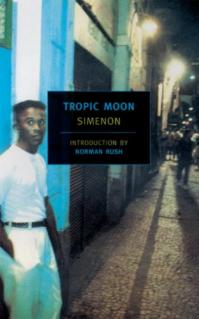|
While Adèle can
be compared to other femme fatales such as Phyllis D. in
Double
Indemnity or any other James M. Cain female or even Kitty in Maugham's The
Painted Veil (although the setting is more appropriate than the character,
perhaps), her self-assured relentless amorality takes on a larger, more
symbolic identity than that of a mere hot woman with nothing better to do.
Going deep, the real comparison for Adèle is to Camus' Meursault -- who
came later -- another French colonial who murders a native just to get rid of
him, as you would swat a bug or step on an insect. Of course the usual
comparison for L'Etranger is to La Nausée (1938), Sartre's classic novel
of existential angst... and you know, in a very general way, La Nausée
has some resemblance to Tropic Moon, which is saturated with physical and
mental nausea. Who influenced who, exactly? Or is it rather that these three
writers were drawing from the common pool of a maladjusted culture -- not just
French -- that is, the modern secular sickness of rippling disbelief.
Certainly Camus -- the
Oran schoolteacher -- admitted hijacking the "hardboiled" American style of
Hemingway and James M. Cain, and if you look at Simenon, you have to say he was
hardboiled right from the start, despite the softer Inspector Maigret series
that made him rich. Tropic Moon annoyed a lot of French people when it came
out, apparently. The face in the mirror was too ugly. The character of
Adèle was beyond the pale, misogynist even. A classless French
adventuress slapping the natives around, committing murder, stitching up a
patsy... a bullet and a heartless shag her two main weapons, all this sordid
stuff going down just over the horizon out-of-sight in Gabon, equatorial
Africa. Dengue? Jungle fever? It certainly gets Timar, her latest love toy. In
Herbert Lottman's massive 1979 biography of Albert Camus, he says "a Finnish
economic geographer" told him him that when Meursault pulled the trigger, "it
was a textbook example of the effect of climate on the population." (244)
This pretty well syncs
with Simenon's anti-colonial views: white people should stay out of Africa, let
the Africans find their own way. As Joe Timar travels up river, he catches
jungle fever and is certainly never the same thereafter... although the bug
that bit him was a woman, first day in town. Later he succumbs to sunstroke,
becomes a raving paranoid idiot... yet although his paranoia turns out to be
justified, it's certainly not tolerated by the white clique in Libreville, and
he's expelled from the colony, sent back to La Belle France to disappear into
bourgeois conformity.
So, zombies were once
idealists too. As usual, some electric Simenonian detailing along the way, some
outrageous incidents and superb characterizations all framed within the utter
absurdity of cultures in collision. Who can forget the sordid, drunken wee
hours orgy under the "tropic moon" involving the white patrons of the
Libreville hotel and some native women they round up, then abandon 20 klicks
from their village? "Moonstroke", for sure... and although Timar is just an
uncomfortable witness, he eventually succumbs to the promiscuous lure of the
jungle when he shags a village chief's nubile daughter somewhere down-river
during his desperate pursuit of Adèle. Wearing a white suit doesn't
remove a man from the cycle of bodily functions, it seems.
Then, in a stroke of
genius, Simenon draws out his color symbolism by having Timar's white suits
confiscated before he's put on the steamer for home; he failed as a colonial,
as a white man, and now he exits wearing a black suit, like a mourner at his
own funeral, an exoskeleton that signals his total corruption... or failure...
or the disease his lover in black gave him.
"They were
standing, their bodies like two pale smudges in the room."
Simenon: a great
writer? A match for Celine? Better than Maugham, perhaps? Because of the
period, comparisons of their subjects and themes are inevitable, of course. For
a long time Simenon's 'hard fiction' (romans durs) drifted out-of-print
in English -- perhaps displaced by his popular Inspector Maigret stories -- but
now (2015) Penguin is busy bringing back many of these forgotten titles. You
can get Tropic Moon as a Kindle eBook, or, if you're willing to pay the cult
premium, find a used New York Review Books Classics paperback ("A brutal and
clueless enactment of interwar French imperialism," says Norman Rush in his
excellent introduction to this edition).
Tropic Moon at
Amazon:
US
|
Canada
|
UK
*Check out LR's
novel
RADIO
BRAZIL »»
|
